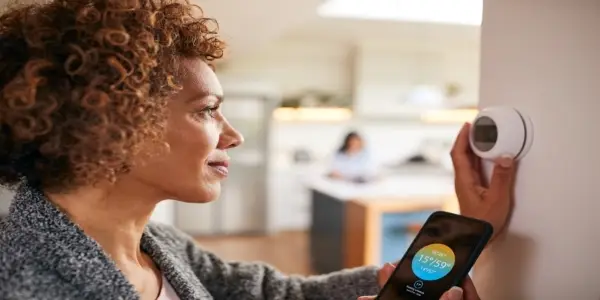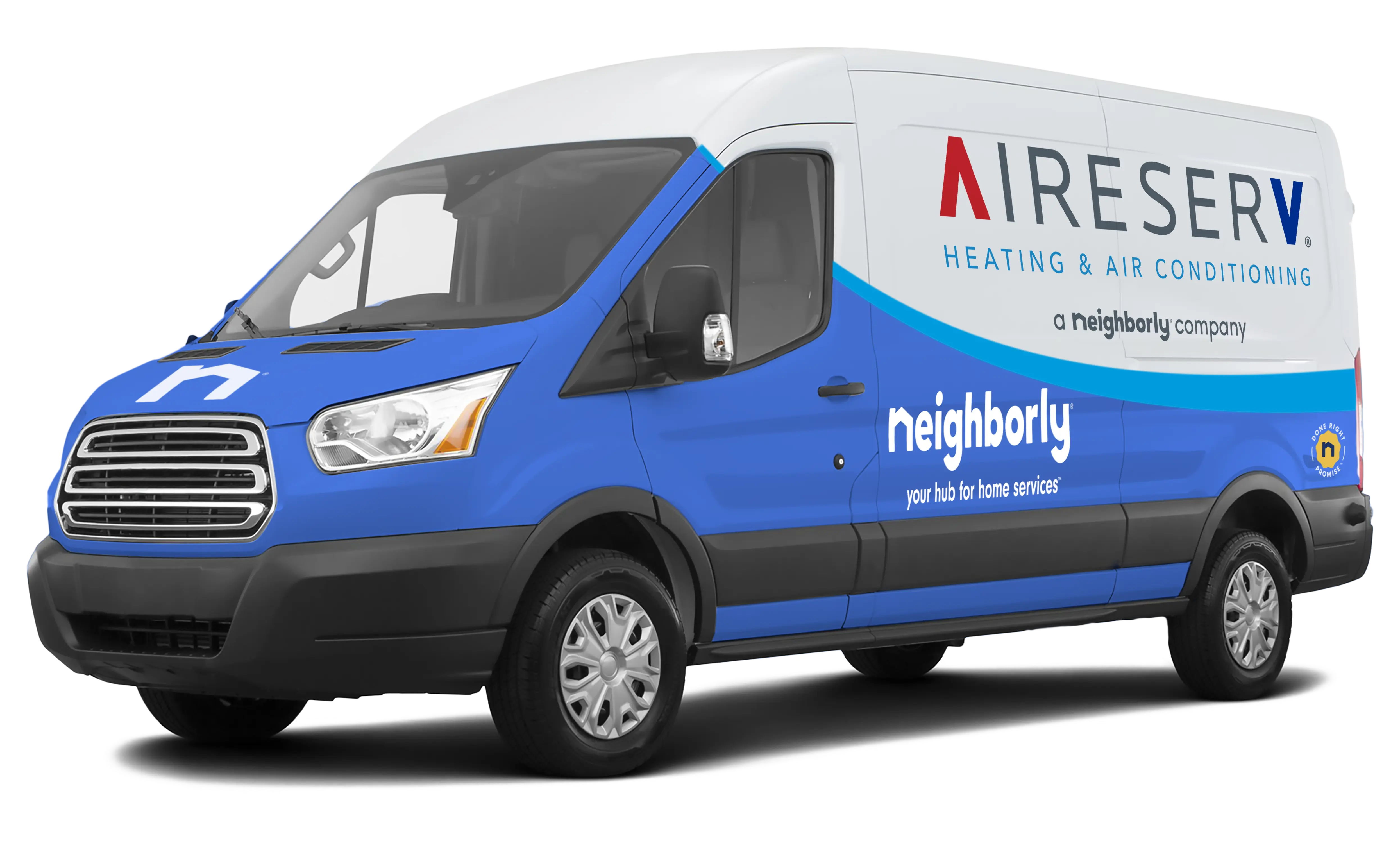
Aire Serv recommends setting your AC to the most efficient temperature for comfort and savings.
- Set your thermostat to 78°F when home.
- Increase the temperature when away.
- Use ceiling fans to boost cooling.
- Maintain your AC system regularly.
- Seal leaks to prevent cool air loss.
These days, it seems like everything costs just a little more. As food, gas, and energy costs continue to increase, we all look for opportunities to save some money. So, we have a few suggestions that can help lower your energy costs during warm weather.
When it comes to the temperature setting of your thermostat, most people set it for comfort and forget it. That is, until it gets noticeably too cold or too warm. But is there an ideal temperature setting for your thermostat during warmer months that is both comfortable and energy efficient? Yes! The ideal temperature setting for your AC during warmer months is actually 78 degrees. However, this temperature is not necessarily set in stone because there are several variables to consider that could change this optimal AC setting. Some of these variables are:
- Time of day
- What activities you are performing
- Humidity levels inside the house
In the article that follows, we’ll review the best AC temperature setting for each scenario and time of day. We’ll also explain how these settings can help you save money and improve the overall health of your AC unit.
What Is the Ideal House Temperature?
Time of Day
One of the biggest factors that affects AC temperature setting is the time of day. Outside temperature in the early morning and late evening will often be cooler than in the middle of the day. During these times, you may want to adjust your thermostat up or down to correlate with the temperature outside.
Day Time
Your daytime thermostat setting can be split into two different time periods: early morning and mid-morning to late afternoon.
- 6:00 a.m. – 12:00 a.m.
Even during warmer days, the temperatures in the morning hours from 6 a.m. to noon are not usually as hot as the afternoon to evening hours. During these times, you may want to turn the temperature of your AC up a few degrees. This helps ensure your air conditioner is not running needlessly to cool an already comfortable house.
- 12:00 a.m. – 6:00 p.m.
On the other hand, noon to 6 p.m. or 7 p.m. is usually the hottest time of the day. To combat these hot and often humid conditions, it may be necessary to drop your temperature setting below 78 degrees to 72-74 degrees Fahrenheit. However, if everyone in your home is still at school or working, you may want to leave the temperature set at 78 to avoid cooling an empty house.
It’s important to remember that your air conditioner also keeps the humidity out of your house. If the thermostat is set too high, it creates a damp, humid environment. Such conditions can be a problem because it can lead to the development of mold, drywall damage, or even worse, warped floors, walls, and ceilings. If you feel the humidity inside your home has increased, turn your thermostat down a few degrees to reduce the moisture level. It will help create a drier environment.
Evening
The evening hours of late summer and early fall can be a little tricky. On the one hand, it’s usually not as warm outside when the sun goes down. On the other hand, the evening hours are usually when everyone is at home and active. If this is the case, it may be necessary to keep your thermostat set at 72-74 degrees until everyone goes to bed. This can also depend on the number of people living in the house, or even whether you’re preparing a home-cooked meal. If it’s just you and your spouse, you may be fine with the temperature set at 75-77. But if you have kids and pets running around, or you’re cooking and using your oven, these things can all raise the indoor temperature noticeably. So, you might find a temperature setting in the 72-74 range more comfortable.
Night Time
Your nighttime temperature setting should be like your early morning setting. However, most people prefer to set the thermostat to a lower temperature at night to create a more comfortable environment for sleeping (more on this later). If you’re an early riser and usually the first one out of bed in the morning, set the thermostat to a more comfortable daytime temperature. The good news is that a lower nighttime temperature setting will help keep your house cooler during the early and mid-morning hours.
Ideal Temperature Settings to Beat the Heat
Activities
School and/or Work from Home
If you have children who are home-schooled, or you work remotely from home, keeping your house cool and dry will be important to help maintain productivity throughout the day. Most people work better and are more productive when with a temperature setting in the 72–74-degree range. This setting is low enough to keep the house cool and dry and keep you and the kids awake during the afternoon hours.
No One Home
One great way to lower energy costs is to avoid cooling an empty house. This is especially true during the middle of the day. If everyone in your household is either at work or school, then turning the temperature to 78-80 degrees will save you a chunk of change when the energy bill arrives. The one consideration to keep in mind is if you have four-legged friends at home. If this is the case, a temperature setting in the 76-78 range is best.
Sleeping
Everyone is different when it comes to creating a comfortable sleeping environment. Some people like it a little warmer, especially if you’re accustomed to sleeping with just a sheet or light blanket over you at night. However, others want to feel like they’re camping out in Antarctica overnight. Most sleep research suggests a cooler nighttime environment is better for promoting good sleep. So, if you don’t mind sleeping with a sheet or light blanket at night, you can save money, keep your AC from running at night, and still get a good night’s sleep if you keep the thermostat set between 74-76 degrees. If you can’t handle the heat, then you may need to leave the temperature set at a cooler 70-74 to create your ideal sleeping conditions.
Related Topic: What Is the Best Temperature for Sleeping
Programmable Versus Smart Thermostats
Overall, the best way to control the temperature of your house - and save money in the process - is by utilizing either a programmable or a smart thermostat.
Programmable Thermostats
Programmable thermostats allow you to determine your temperature setting at different times of day without having to manually change the temperature each time. A programmable thermostat usually includes 6 or 8 different programable settings for different times of day.
The upside of a programmable thermostat is that once you set the temperature for each time of day or night, you don’t have to touch it again. Of course, you always have the option to go back and change the settings if you desire, but you won’t be required to.
Smart Thermostats
Smart thermostats are all the rage now - and with good reason. These thermostats are truly smart and very good at learning and understanding your preferred temperature settings. Although these devices can be manually programmed, once they gather enough data, they can also program themselves.
A smart or learning thermostat will learn what you want the temperature to be during the different times of day and night. It will automatically adjust the temperature setting to your preferred temperature. You can also connect a smart thermostat to your Wi-Fi and control it with your phone. This is especially handy if you are on a trip and forgot to turn your air conditioner or furnace off. If you don’t already have a smart thermostat, you might want to consider getting one installed.
Get Advice from the Pros
Whether it’s finding the lowest gas price, using coupons when you shop, or finding the optimal setting for your thermostat, saving a little money here and there can really add up. Plus, finding the most efficient temperature setting for your thermostat can also help reduce maintenance and extend the life of your AC system. If you have any questions, the local, trusted HVAC professionals at AirServ can help. We're your go-to for any questions you have regarding AC repair, maintenance, and installation. Give us a call today!
This article is intended for general informational purposes only and may not be applicable to every situation. You are responsible for determining the proper course of action for your home and property. Aire Serv is not responsible for any damages that occur as a result of this blog content or your actions. For the most accurate guidance, contact the Aire Serv location nearest you for a comprehensive, on-site assessment.
FAQs About the Best Settings for an Air Conditioner
As an industry leader and a brand that is trusted by homeowners and businesses nationwide for our knowledge and experience, we’re happy to answer your HVAC questions. Here are answers to some of the frequently asked questions about the best setting for an air conditioner.
What is the best AC temperature for energy saving?
According to the U.S. Department of Energy, the best AC temperature for saving energy is 75–78°F (25.5°C) when you're at home and need cooling. Increase the temperature by about 7°F when no one is home to significantly reduce energy consumption.
Each degree you raise the thermostat can save about 1% to 3% on cooling costs. Using fans in conjunction with a slightly higher thermostat setting can create a similar cooling effect while using less energy.
Learn more about energy saving with your HVAC system:
- Energy Saving Tips
- Improve Your Home’s Energy Efficiency
- Saving Energy in Your Home: Helping the Environment
What temperature should I set the air conditioner in summer?
According to the U.S. Department of Energy, the recommended AC temperature for summer is 78°F (25.5°C) when you're at home. However, comfort is subjective, and you may need to adjust this based on your personal preferences and humidity levels.
Pro Tip: Setting the thermostat low when you're away is a waste of energy and doesn't cool your home down any faster when you return.
What temperature should AC be on?
Adjust your AC temperature settings for optimal comfort and energy savings.
- During the day (when you're home): Aim for 78°F (25.5°C) as a starting point. Adjust a few degrees up or down based on your personal comfort and humidity levels.
- When you're away: Increase the temperature to around 85°F (29°C) or even a bit higher. There's no need to cool an empty house.
- At night (while sleeping): A slightly cooler temperature, typically between 72–75°F (22–24°C), is often more comfortable for sleep.
Remember, each degree you raise the thermostat can save you 1% to 3% on cooling costs! Installing a programmable or smart thermostat allows you to automate these changes based on your schedule.
Is it better to raise the thermostat or keep the AC at high temperatures?
It's generally better to raise the thermostat temperature when you don't need active cooling than to keep the AC running at a consistently high (but still cooling) temperature.
The most significant energy savings come from reducing the temperature difference between inside and outside. Raising the target temperature to do so means the AC unit runs less frequently and for shorter durations, consuming less energy overall. Running the AC at a high cooling temperature requires the compressor to cycle on and off to maintain that set point, which uses more energy than simply setting a warmer target.
What is the best time to turn on the AC to save money?
Start the AC in the morning when outdoor temperatures are cooler. This allows your system to work less to achieve and maintain a comfortable indoor temperature throughout the day. Timing your AC use can help reduce its overall runtime and potentially lower your energy bills.
Consider these strategies:
- Pre-cool your home: Turn on the AC in the early morning to cool your house before the hottest part of the day. Pre-cooling can allow you to use the AC less during peak afternoon hours.
- Avoid peak hours: Many municipalities charge more for electricity during peak demand times, typically in the late afternoon and early evening (about 3–7 p.m.). If possible, minimize AC use during these hours.
- Smart thermostat scheduling: Program your thermostat to start cooling before you wake up or return home, rather than turning it on when the house is already hot.
Commercial settings with larger spaces to cool can benefit from commercial thermostats that activate only during business hours.
Is 72° a good temperature for air conditioning?
Many people consider 72°F (22°C) a comfortable indoor temperature, especially for sleeping. However, from an energy-saving perspective, it's on the cooler side.
While 72°F can feel very refreshing, raising the thermostat a few degrees can help you save on your energy bills without a drastic change in comfort, especially when you're not active. Supplement your AC with fans to feel cooler at a slightly higher temperature.
How do I maintain my thermostat?
Thermostats are generally reliable, low-maintenance devices. However, if you’ve noticed inconsistent temperatures in your home or office, a checkup may be helpful.
- Regular cleaning: Dust and debris can accumulate inside the thermostat, affecting its ability to read the temperature correctly. Gently remove the cover and use a soft brush or compressed air to clean the internal components. Clean the cover with a damp cloth.
- Battery replacement: If your thermostat is battery-powered, replace the batteries annually or when the low battery indicator appears.
- Check wiring: Periodically inspect the wiring connections for any looseness or corrosion. If you notice any issues, consult a qualified electrician.
- Calibration check: To ensure accuracy, compare your thermostat's reading with a separate, reliable thermometer placed nearby. If there's a significant difference (more than a few degrees), your thermostat may need calibration. Consult your thermostat's manual for calibration instructions, as the process varies by model. Some smart thermostats have built-in calibration features.
- Avoid extreme temperatures: Ensure the thermostat isn't exposed to direct sunlight, drafts, or heat sources, as these can affect its readings.
- Professional maintenance: Schedule regular HVAC maintenance, including a thermostat check, by a qualified service professional. They can identify and address potential issues you might miss.

